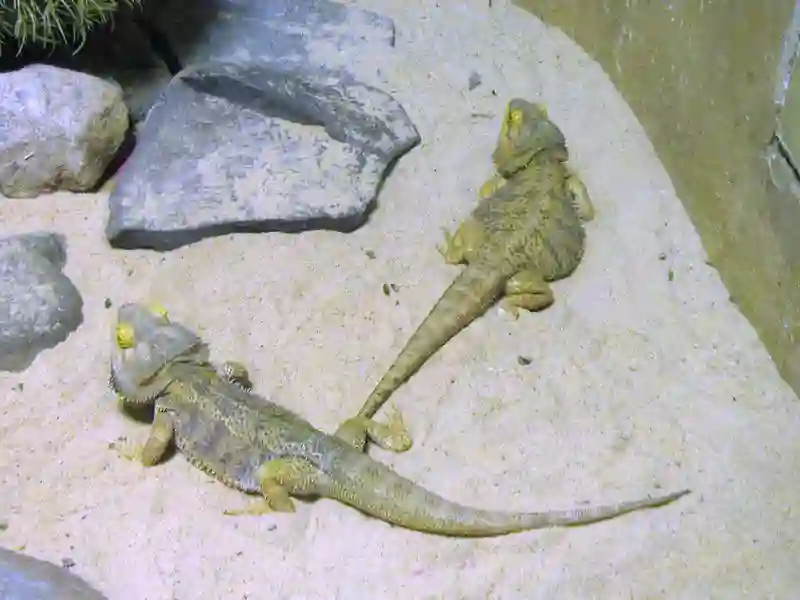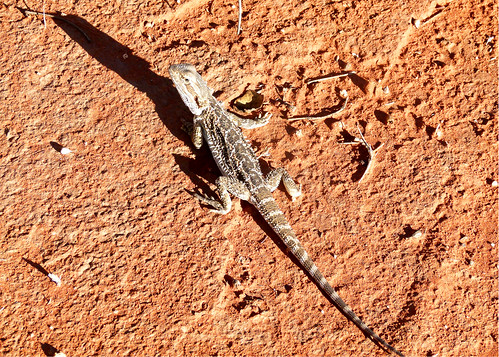After talking to some bearded dragon owners, I’ve been able to come to a conclusion that, yes you can but here are three things you must know:
Why you should not use sand:
- Loose substrates such as sand can cause impaction if accidentally eaten, which is a serious health issue and the risk is especially high in baby bearded dragons.
- Sand can build up over time and create a blockage in the bearded dragon’s gastrointestinal tract that can be fatal.
- Using only sand as substrate over a long period of time can be bad for your bearded dragon’s joints.
Why you can use sand:
- Sand allows digging, which is a natural behavior in bearded dragons.
- Using sand for bearded dragon substrate can be an attractive and enriching part of your bearded dragon’s captive environment when done correctly.
- Bearded dragons can have sand in their tank once they are fully grown, usually around a year old.
What type of sand to use:
- Non-silica sands are suitable substrates for adult bearded dragons without worry of the chance of impaction. Make sure the sand is clean and free of foreign debris.
- Using a calcium-based sand, such as Vita-Sand, can be an option as it will become metabolized when swallowed, allowing the bearded dragon to easily pass it.
- Using actual Australian sand/soil harvested from Central Australia can be a natural option.
Pros and Cons of Sand as Substrate for Bearded Dragons
Advantages of using sand as substrate
Sand is a popular choice for bearded dragon owners because it provides a natural look and feel that mimics the reptile’s natural habitat. It also allows for digging and burrowing behavior, which is important for their mental and physical well-being.
Moreover, sand can help with the natural wear down of nails, which is important to prevent overgrown nails that can lead to health problems. However, not all sands are created equal.
It’s important to use calcium-based sand specifically made for reptiles because other types of sand (like playground or construction sand) may contain contaminants that can harm your pet. Always read the label carefully before purchasing any type of reptile substrate.
Disadvantages of using sand as substrate
One major concern with using sand as a substrate for bearded dragons is the risk of impaction if it’s ingested. This happens when small particles of sand get stuck in their digestive system, causing blockages that can be fatal if not treated promptly. Additionally, dusty sands can cause respiratory problems in both humans and pets.
Be sure to choose a low-dust option or mist the enclosure regularly to keep dust levels down. Cleaning a sandy enclosure can also be difficult because feces and uneaten food tend to sink into the substrate rather than staying on top like they would on other types of substrates like reptile carpets or paper towels.
Daily spot cleaning is necessary but you will still need routine cleanings where everything must be removed from the enclosure and washed thoroughly.
Alternatives to Sand Substrate for Bearded Dragons
While sand may be a popular choice as a substrate for bearded dragons, there are many other options available. The following alternatives provide a safe and healthy environment for your pet.
Reptile carpet or paper towels
Reptile carpets and paper towels are two popular alternatives to sand substrate. They are both easy to clean and don’t pose any risk of impaction or dust inhalation. Reptile carpets come in a variety of colors and textures and can be cut to fit the size of your tank.
Paper towels, on the other hand, provide a cost-effective temporary solution if you need to remove your bearded dragon from its usual habitat for medical reasons. Both options are suitable for hatchlings and adults alike.
Ceramic tile or slate flooring
Ceramic tiles and slate make excellent choices for flooring in bearded dragon habitats because they are easy to clean and don’t absorb moisture or odors.
They also provide a solid surface that helps with natural nail wear-down when your pet is moving about its habitat. Ceramic tiles come in various colors, shapes, and sizes, giving you the flexibility to create unique designs or patterns in your dragon’s home.
Coconut coir or organic soil
If you’re looking for an alternative that will mimic the natural environment of wild bearded dragons, coconut coir or organic soil may be the perfect option.
Coconut coir is a type of fiber extracted from coconut husks that can hold moisture while still allowing air circulation throughout the substrate. Organic soil is another alternative that can promote natural burrowing behavior while being free from harmful chemicals often found in commercial potting mixes.
When choosing an alternative to sand substrate for your bearded dragon, consider factors such as safety, hygiene, and the natural habitat of your pet. By selecting a suitable option from the ones detailed above, you can provide a healthy and enjoyable environment for your beloved pet.
Tips for Using Sand Substrate Safely
While sand can be a great substrate option for bearded dragons, it is important to use it safely to avoid any potential health risks. Here are some tips for using sand substrate safely:
Use fine-grain, calcium-based sand specifically made for reptiles
When selecting sand substrate, it is essential to choose fine-grain, calcium-based sand that is specifically made for reptiles. This type of sand will help reduce the risk of impaction if ingested by the bearded dragon.
The calcium in the sand can also be beneficial to your pet’s health as it helps with bone development and maintenance. Avoid using coarse sands that can cause abrasions on your beardie’s belly or feet.
Avoid using colored or scented sands
Sand substrates come in many colors and scents. However, these options may not be safe for your pet and should be avoided. Colored sands may contain dyes that can harm your beardie if ingested, while scented sands often contain perfumes that could irritate their respiratory tract or eyes.
Monitor your bearded dragon’s behavior and bowel movements regularly
Even when using a safe and appropriate sand substrate, there is still a risk of impaction if too much is ingested by your pet. Therefore, It’s important to regularly check their feces to ensure they are digesting their food properly and do not have any signs of impaction like lack of bowel movement or bloating.
It’s also recommended that you monitor how much time they spend burrowing in the substrate as this could indicate they are not feeling well or have an underlying medical issue.
By following these tips on how to use sand safely as a substrate for bearded dragons, you can greatly reduce the risk of impaction and other common health problems associated with sand substrate use. Be diligent in monitoring your pet’s behavior and feces to avoid any potential issues and provide them with a healthy and safe environment.
Conclusion
After analyzing the pros and cons of using sand as a substrate for bearded dragons, it is clear that while there are some advantages to using sand, there are also several risks associated with it.
These risks include impaction if ingested and respiratory problems if too dusty. Therefore, before deciding whether or not to use sand in your bearded dragon’s cage, it is important to weigh the benefits against the potential risks.
Alternative Substrates
Fortunately, there are several alternative substrates available that can provide a safe and comfortable habitat for your bearded dragon. Reptile carpets or paper towels are easy to clean and do not pose any risks of impaction when ingested.
Ceramic tile or slate flooring can also provide a solid surface for your bearded dragon to walk on while still allowing for easy cleaning. If you want a more natural look and feel, coconut coir or organic soil can provide a safe substrate option.



Leave a Reply